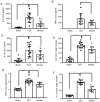Ghrelin regulates sepsis‑induced rat acute gastric injury
- PMID: 31059095
- PMCID: PMC6522907
- DOI: 10.3892/mmr.2019.10208
Ghrelin regulates sepsis‑induced rat acute gastric injury
Abstract
Ghrelin, a peptide expressed in the gastric mucosa, has an essential role in sustaining the normal function of the digestive system. Sepsis is one of the primary causes of mortality in intensive care units and can lead to multiple organ dysfunction, especially in the gastrointestinal system. The aim of the present study was to explore the effect of ghrelin on gastric blood flow in a rat model of sepsis, as well as the effect of ghrelin on the expression of the apoptotic markers, B‑cell lymphoma 2 (Bcl‑2) and Bcl‑2‑associated X (Bax), in gastric tissues. The sepsis model was established using cecal ligation and puncture (CLP). The expression levels of apoptosis‑related factors in gastric epithelial cell were determined by immunohistochemistry, reverse transcription quantitative‑PCR and western blotting. Collectively, the present results suggested that ghrelin administration attenuated sepsis symptoms induced by CLP. Blood flow in the stomach greater curvature was significantly higher in the CLP‑induced sepsis group rats (284.3±95.7 perfusion units) compared with the sham operation group (317.8±5.2 perfusion units; P<0.05), whereas there was no difference between the CLP group treated with ghrelin (377.8±99.0 perfusion units) and the sham rats. Ghrelin administration also reduced the secretion of pro‑inflammatory cytokines compared with the CLP‑induced sepsis group rats. In addition, CLP significantly reduced the expression of Bcl‑2 and enhanced the expression of the pro‑apoptotic proteins, Bax and cleaved caspase‑3; whereas, ghrelin application reversed the effects of CLP on these apoptosis‑associated proteins. In conclusion, the present study revealed that ghrelin has the ability to increase blood flow in the gastrointestinal tract in a sepsis model and can also regulate the expressions of apoptosis‑associated factors in gastric tissues. These results suggest that ghrelin could be a novel treatment for sepsis‑induced gastric injury.
Figures





References
-
- Lever A, Mackenzie I. Sepsis: Definition, epidemiology, and diagnosis. BMJ. 2007;335:879–83. doi: 10.1136/bmj.39346.495880.AE. - DOI - PMC - PubMed
-
- Lang CH, Bagby GJ, Ferguson JL, Spitzer J. Cardiac output and redistribution of organ blood flow in hypermetabolic sepsis. Am J Physiol. 1984;246:R331–R337. - PubMed
MeSH terms
Substances
LinkOut - more resources
Full Text Sources
Other Literature Sources
Medical
Research Materials
Miscellaneous

